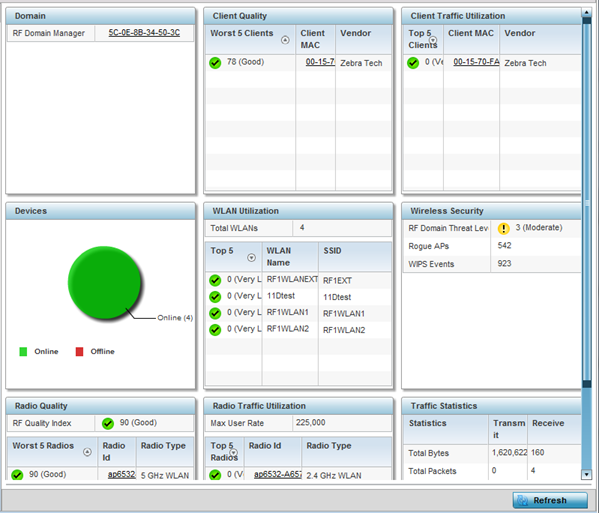Health
The Health screen displays general status information for a selected RF Domain, including data polled from all its members.
To display the collective device membership health of a controller, service platform or AP RF Domain:
- Select the menu from the Web UI.
- Select an RF
Domain from the list.
The RF Domain statistics menu displays in the right-hand side of the screen, with the Health tab selected by default.

- Review the different fields displayed on the screen:
- Domain - Displays the name of the RF Domain manager. The RF Domain manager is the focal point for the radio system and acts as a central registry of applications, hardware and capabilities. It also serves as a mount point for all the different pieces of the hardware system file.
- Devices - Displays the total number of online versus offline devices in the RF Domain, and an exploded pie chart depicts their status.
- Radio Quality - Displays information on the RF Domain's
RF quality. The RF quality index is the overall effectiveness of the RF
environment as a percentage of the connect rate in both directions, as well as
the retry and error rate. This area also lists the worst 5 performing
radios amongst all the RF Domain device member radios.The RF Quality Index can be interpreted as:
- 0-20 – Very poor quality
- 20-40 – Poor quality
- 40-60 – Average quality
- 60-100 – Good quality
Refer to the Radio Quality table for RF Domain member radios requiring administration to improve performance:
Worst 5 Radios Displays five radios with the lowest average quality in the RF Domain. Radio ID Lists each radio‘s administrator defined hostname and its radio designation (radio 1, radio 2 or radio 3). Radio Type Displays the radio type as either 5 GHz or 2.4 GHz. - Client Quality - Refer to the table below for RF Domain
connected clients requiring administration to improve performance:
Worst 5 Clients Displays the five clients having the lowest average quality indices. Client MAC Displays the hard coded radio MAC of the wireless client. Vendor Displays the vendor name of the wireless client. - WLAN Utilization - Refer to the table below to assess
WLAN related information:
Total WLANs Displays the total number of WLANs managed by RF Domain member access points. Top 5 Displays the five RF Domain utilized WLANs with the highest average quality indices. WLAN Name Displays the WLAN Name for each of the Top 5 WLANs in the access point RF Domain. SSID Displays the SSID for the WLAN. - Radio Traffic Utilization - Refer to the following table
to identify radios requiring administration to improve performance:
Max. User Rate Displays the maximum recorded user rate in kbps. Top 5 Radios Displays five radios with the best average quality in the RF Domain. Radio ID Lists each radio‘s administrator defined hostname and its radio designation (radio 1, radio 2 or radio 3). Radio Type Displays the radio type as either 5 GHz or 2.4 GHz. - Client Traffic Utilization - Refer to the following table
for wireless client related information:
Top 5 Clients Displays the five clients having the highest average quality indices. Client MAC Displays the client‘s hard coded MAC address used a hardware identifier. Vendor Lists each client‘s manufacturer. - Wireless Security - Indicates the security of the
transmission between WLANs and the wireless clients they support. This value
indicates the vulnerability of the WLANs.
RF Domain Threat Level Indicates the threat from wireless clients trying to find network vulnerabilities within the RF Domain. The threat level is represented by an integer. Rogue APs Lists the number of unauthorized APs detected by RF Domain member devices. WIPS Events Lists the number of WIPS events generated by RF Domain member devices. - Traffic Statistics - Displays the following information
for transmitted and received packets:
Total Bytes Displays the total bytes of data transmitted and received within the RF Domain. Total Packets Lists the total number of data packets transmitted and received within the RF Domain. User Data Rate Lists the average user data rate within the RF Domain. Bcast/Mcast Packets Displays the total number of broadcast/multicast packets transmitted and received within the RF Domain. Management Packets Displays the total number of management packets processed within the RF Domain. Tx Dropped Packets Displays the total number of dropped data packets within the RF Domain. Rx Errors Displays the number of errors encountered during data transmission within the RF Domain. The higher the error rate, the less reliable the connection or data transfer. - SMART RF Activity - Refer to the table below for
details:
Time Period Lists the time period when Smart RF calibrations or adjustments were made to compensate for radio coverage holes or interference. Power Changes Displays the total number of radio transmit power changes that have been made using SMART RF within the RF Domain. Channel Changes Displays the total number of radio transmit channel changes that have been made using SMART RF within the RF Domain. Coverage Changes Displays the total number of radio coverage area changes that have been made using SMART RF within the RF Domain.
- Periodically click Refresh to update the contents of the screen to their latest values.

